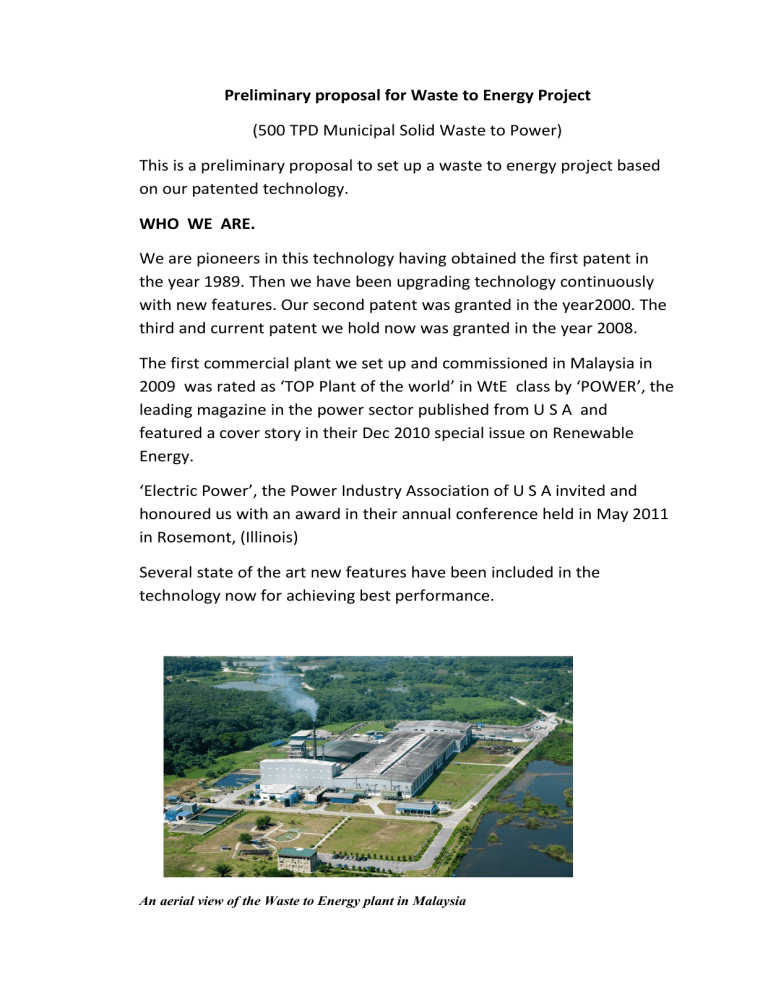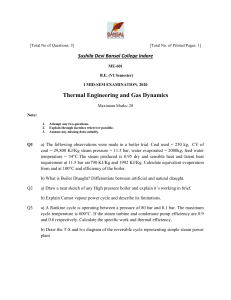
Preliminary proposal for Waste to Energy Project (500 TPD Municipal Solid Waste to Power) This is a preliminary proposal to set up a waste to energy project based on our patented technology. WHO WE ARE. We are pioneers in this technology having obtained the first patent in the year 1989. Then we have been upgrading technology continuously with new features. Our second patent was granted in the year2000. The third and current patent we hold now was granted in the year 2008. The first commercial plant we set up and commissioned in Malaysia in 2009 was rated as ‘TOP Plant of the world’ in WtE class by ‘POWER’, the leading magazine in the power sector published from U S A and featured a cover story in their Dec 2010 special issue on Renewable Energy. ‘Electric Power’, the Power Industry Association of U S A invited and honoured us with an award in their annual conference held in May 2011 in Rosemont, (Illinois) Several state of the art new features have been included in the technology now for achieving best performance. An aerial view of the Waste to Energy plant in Malaysia The process in brief. Municipal solid waste( MSW) is received processed in steps to segregate the combustibles and reduce moisture content by drying. Then after removing metals & other inerts subjected to shredding process to make RDF, a homogenised matrix suitable to use as fuel in boiler furnace to achieve good efficient combustion. Pollution Prevention is the underlying basis for the next steam and power generation process. Boiler furnace is specially designed to facilitate two part combustion to reduce formation of Nitogen Oxides (NOx) a pollutant. Furnace temp & gas residence time in the furnace is controlled to disintegrate Dioxin, another deadly pollutant that forms during combustion. Injection of urea in the flue gas stream further reduces NOx by disintegration. Chlorine and Sulphur compounds in the waste generate acidic fumes. A host of heavy metals present in MSW like mercury, cadmium, arsenic, zinc, lead, etc are vapourised in the furnace and migrate with flue gas towards chimney passing through the pollution abatement system of the boiler consisting of a dust separator, dry scrubber, bag filter and wet scrubber. Dust is trapped & removed in dust separator. Acid fumes are neutralised heavy metals are adsorbed & removed. The cleansed gas leaves for the chimney. Here the flue gas is drawn and subjected to a process of carbon sequestration to remove carbon dioxide before exiting the chimney. Thus cleanest emission as per international standards is achieved. The Plant Operation. Waste is received in the waste receiving pit. Leachate is allowed to drip to bottom channel leading to effluent treatment plant where it is treated, recycling the treated water to plant for washing purposes. Waste is then fed in to Rotary Screen after primary shredding. Here the wet organics are separated and sent to special drying system for moisture reduction before joining the main stream drying line. The bulk of the waste of middle size is segregated and sent to the main drying system for moisture reduction. The balance large size species, mainly plastics newspapers cardboard etc. are sent for sorting, packing and sale as by product. In the Drying section waste is fed in to a hot air stream in Rotary Dryer for moisture reduction. The hot air is generated by steam coil heaters using extraction steam from turbo generator thus increasing system thermal efficiency. After drying, Metals are removed by magnetic separation and a double shredding process delivers RDF as a homogenised matrix sent to the boiler house for steam generation. Operational mode The RDF plant will operate for 16 Hrs a day and produce enough RDF for operation of power plant for 24 Hrs a day thus allowing time for cleaning and daily maintenance of RDF plant. Boiler needs a mandatory stoppage for a few days in a year for cleaning and licence renewal resulting in plant stoppage. In order to facilitate plant operation all through 365 days of the year, we have adopted two boiler system and keep plant operation without stoppage maximising annual power output for sale. Plant Performance The output of fuel RDF, steam & power greatly depends on the composition of MSW, moisture content etc. Electricity output depends basically on these factors besides other local conditions. At this stage, with limited knowledge of these factors we give here the performance projections as envisaged, as guideline. Daily receipt of MSW at plant site 500 Tons. Average moisture content of MSW 52 % Out of this wet organics segregated 125 tons Moisture content of wet organics 62 % Expected RDF output at 25 % moisture 235 tons Steam generation capacity MCR 50 TPH Power generation capacity MCR 10 Mw Hr Operation performance Envisaged With tipping fee at 28 US $ / ton waste delivered at site and Electricity Tariff at 0.08 US $ / Kwhr power supplied to Grid & Revenue from By products sale, may generate an operating surplus over 50 %. Once DPR (Detailed Project Report) is prepared, more precise financial performance will be prepared. Capital Investment in US $ Civil construction works 10.0 Million (including buildings & all other amenities) RDF Plant two processing Lines 20.0 Million (including Rotary Screens, Rotary Driers, Apron Driers, Magnetic Separators, Crane Feeders, Double Shredders and all other Auxiliaries) Power Plant 28 Million (Including two boiler system, fuel feeding, pollution abatement system, ash handling, water treatment, turbo generator, cooling water system, HT electrical system, power evacuation system, model carbon sequestration system and all other auxiliaries ) Technology acquisition Patent Licensing cost @7.5%of total assets) Technical services cost (for 2 years) 3 Million 2 Million (for our technical oversight services till commissioning) Total USD 63.00 Million Project Implementation Promoter forms project company, an SPV (Special Purpose Vehicle) Patent holder will grant ‘User rights’ of patent to SPV as per Patent agreement. Then a technical services agreement will be signed between patent holder’s company and SPV for rendering technical oversight services through project implementation till commissioning. Payments First, User Rights payment will be made to patent holder as per patent Agreement. Then, as per Technical Services Agreement payment for mobilisation will be released. With this the project activities will start. TimeLine for project construction Mobilisation of Design Set up. MSW supply, land leasehold agreements initial permission for project construction by environment ministry, patent & technical services agreements, any other statutory clearances must all be in place. Timeline envisaged 3 months. Mobilisation of project finances leading to financial closure Firm up Engineering, Procurement, Construction, Commissioning EPCC Preliminary work on preparation for construction work on land to be carried out. TimeLine envisaged 3 months Plant procurement & installation. TimeLine envisaged 18 months Trials and commissioning Timeline envisaged 6 months The Technical Services Agreement will spell out the responsibilities of the SPV management group and the technical services group in getting the project up to commissioning. For further details, please contact our representative for Sri Lanka and Maldives, Asanka Sri narth Gurusinghe Chairman / Managing Director C/o Ayodhya Ventures Worldwide Pte. Ltd. Voice / Whatsapp/ Viber/ Imo: +94 777319834 / +94 785142137 eMail: ayodhya_ent@yahoo.com.sg asanka.gurusinghe@gmail.com


